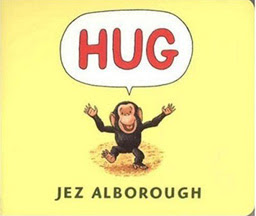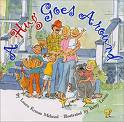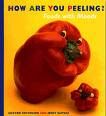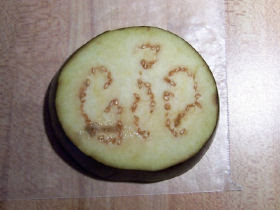
The Construction of Meaning and the Self De(con)struction of Identity: A Hippo-Critical Analysis of Jeff Newman's Hippo! No, Rhino!
Rosco P. Hargrove (Class of 2010)
English 421: Re-Introduction to Literary Criticism
Professor F. R. Zismer
Final Paper
Submitted on: December 22, 2007
Plot Summary
A mischievous zookeeper decides to have some fun and puts a sign that reads "Hippo" in front of the Rhino pen. This seemingly harmless bit of mischief wreaks havoc on the rhino's psyche as passersby continually refer to the rhino as "hippo". The rhino desperately tries to correct them, but to no avail. It isn't until a little boy comes along that things change. The child sees what's going on and changes the sign back to rhino. The book ends with the zookeeper continuing his mischievous ways by putting up a new sign that reads, "Porcupin-o".
Part I: Hippo! No, Rhino! Structuralism! No, Poststructuralism!
Newman's sparse use of language is deceptive. While he uses few words in his narrative, he manages to reveal deeper linguistic issues by drawing together some of the fundamental issues and conflicts in literary criticism.
As a starting point, the basic conflict in Hippo! No, Rhino! is clearly a re-creation of the tension between the structuralist and post-structuralist schools of thought. Newman's Hippo! No, Rhino! situation is an intriguing thought exercise which forces us to reconsider a fundamental question: Where does meaning come from?
Is it from the zookeeper (filling the archetypal role of trickster-god) who creates meaning by labeling the rhino as "hippo"? Or is his semantic subversion just a silly prank?
Is it the people reading the sign who give birth to meaning by creating the link between the sign ("hippo") to the signified (the rhino)? Or are they merely dimwitted automatons who will believe anything they read?
Is there even any meaning to begin with? Who are we (or the rhino) to say that "rhino" is the correct label? Isn't the polyphonic spree of letters and sounds that make up r-h-i-n-o ultimately as arbitrary as h-i-p-p-o?
Part II: Pedagogy of the Zoopressed
If we continue to peel away layers of this onion, we eventually find ourselves alone with the tear-jerkingly tragic figure of the "rhino".
(Note: Though it is awkward, I will refer to the rhino using the pronoun "it" because Newman's text does not indicate whether the rhino is male or female.)
(Full disclosure: Upon first reading, I subconsciously assumed that the rhino was a male, which tipped my hand as an unwitting co-conspirator in the phallocentricity embedded in our male-dominated society. I would like to assure you, professor, that based on last semester's readings on feminist theory and gynocritic analysis, I am sufficiently ashamed.)
Why is the rhino a tragic figure? Not only because it is helplessly tormented by the powerful zookeeper... that is but a minor offense. The true tragedy reveals itself with further examination of the sociolinguistic context of the rhino's self-identification.
The word "rhino," being of English (Anglo-Saxon) origin is obviously not the rhino's native tongue. Yet the rhino has come to identify itself as a "rhino," as evidenced by the psychological distress caused by the hippo sign. This self-identification through the language of his oppressor (and yes, he is oppressed... he is, after all, held captive and put on display) is one of major symptoms of oppression that is revealed by postcolonial theory.
The fact that the rhino clings so passionately and desperately to the name bestowed upon him by his captors, demonstrates the powerful role that language plays in perpetuating the inequalities of established social hierarchy. Not only does he accept his given name, he challenges anyone who dare disrupt the sanctity of his moniker. How can the rhino truly free itself from oppression if it lives, breathes, and thinks in the language of its oppressor?
This also sheds new light on the character of the child. As I mentioned in the plot summary, toward the end of the book a young child comes to the rescue, changing the hippo sign back to rhino.
Upon first reading, the child appears as a saviour figure who sympathetically changes the sign to ease the "rhino's" mind. The child's innocence allows him to see beyond the ridiculous sign and recognize the psychological harm being done to the rhino. And yet...
...and yet, perhaps it is not that simple. By reverting the sign (the linguistic tool of oppression), isn't the child merely reinforcing the domination of the status quo and strengthening the establishment's vice-like grip on society? The child may have acted to ease the rhino's mind but (despite the child's benelovent intentions), in actuality he played an active role in relegating the beast to an eternity of tranquil captivity. He did not rescue the rhino, he merely made his cage stronger.
Part III: Freedom Isn't Free or All Signs Point to "No"
Newman's stimulating text leaves the reader (at least this reader) with a final burning question... Who holds the key to the rhino's freedom?
The optimist's answer would be that the key to freedom lies with the rhino itself. Unfortunately, to quote Karl Marx, "Religion is the opium of the masses and optimism is the ecstasy tablet of the self-delusional." So no, the rhino does not hold the key to his own freedom.
The real answer is much simpler and much more sobering. The key to freedom lies with: the zookeeper. (Seriously, it's on the big key ring that's clipped to his belt buckle.)
This does not bode well for the rhino. At the end of the book, the zookeeper puts up a new sign next to the rhino that reads, "Porcupin-o". In doing so, this sadistic trickster god is assuring us that the rhino's nightmare is not over... and that no amount of lit crit is going to save him from an eternity in this semiotic purgatory. The helpless rhino (like the rest of us) is forever caught in that desolate place between meaning and just plain mean.
Viewing: Blog Posts Tagged with: Aalphabetical: H, Most Recent at Top [Help]
Results 1 - 5 of 5
Blog: Bottom Shelf Books (Login to Add to MyJacketFlap)
JacketFlap tags: Wild Animal Kingdom, Judging a Book By Its Cover, Aalphabetical: H, Wild Animal Kingdom, Judging a Book By Its Cover, Aalphabetical: H, Add a tag
Blog: Bottom Shelf Books (Login to Add to MyJacketFlap)
JacketFlap tags: In the News, Wild Animal Kingdom, Aalphabetical: H, Add a tag

Author/Illustrator: Eric Carle
A young boy loses his cat and travels the wide world to find it. Poor kid. If any of you have lost a pet, you know the kind of pain this little boy is going through... no fun at all.
Luckily, scientists in South Korea have been hard at work on this problem and last week, they finally made a breakthrough with... GLOW IN THE DARK KITTIES!!!
On Tuesday, a team of scientists from Gyeongsang National University announced that they successfully cloned cats that glow in the dark when passed under ultraviolet light. They caution that this does not completely solve the problem of missing pets, but the advance is significant and monumental.... significantly creepy and monumentally disturbing.
So, have I seen your cat?
Yes I have... and it is scaring the crap out of me.
Blog: Bottom Shelf Books (Login to Add to MyJacketFlap)
JacketFlap tags: Miscellaneous, Kids These Days, With Friends Like These..., Aalphabetical: H, Add a tag

From: State Board of Education
Re: New Book Ban
Given the raging hugging epidemic that is threatening to overtake our schools (see Alabama, Illinois, and Virginia), the School Board has decided to take preemptive action to stem this tide of unsanctioned emotion.
In response to this disturbing trend, the school board has passed a Zero Tolerance Policy on Physical Contact. This policy includes, hugs, high fives, handshakes, and all other inappropriate forms of Public Display of Affection (PDAs).
In order to maintain the integrity of this new policy, the following books (see list below) are now banned from all school libraries, classrooms, and personal collections. The School Board has decided (through a unanimous vote) that these titles are no longer appropriate because they promote subversive behavior which may undermine the authority of school administrators.
This ban is effective immediately. A School Board representative will be conducting periodic site visits to ensure that these books are no longer present on school grounds. Schools that continue to carry these titles will be reprimanded immediately through a series of escalating sanctions and funding penalties.
Banned Book List
The following books are banned and are to be extricated from all school grounds immediately. This list, however, is a small sample and should not be considered complete. As a precaution, all books with the word "hug" in the title, or any books featuring any illustrations of hugging or hug-like behavior should be permanently removed or placed under lock and key in a state-approved vault until further notice.
Title: HUG
Author/Illustrator: Jez Alborough
Official Reason for Ban: Monkey See, Monkey Do.
Title: Hug Time
Author/Illustrator: Patrick McDonnell
Official Reason for Ban: No time is Hug Time when you're at school.
Title: A Hug Goes Around
Author: Laura Krauss Melmed
Illustrator: Betsy Lewin
Official Reason for Ban: The contagious nature of hugs is precisely the reason for the Zero Tolerance Policy.
Note: The school board is approaching Ms. Melmed and Ms. Lewin to propose that they revise A Hug Goes Around as a cautionary tale for children that will be used in schools to discourage this inappropriate behavior.
Please distribute this list to all faculty, parents, students, and other concerned citizens. We appreciate your cooperation in this matter and cannot stress enough how vital this is to the educational and social-emotional future of our children. Together, we can rid ourselves of this shocking behavior and minimize the disturbing displays of human emotion that are currently infecting our schools.
Sincerely,
State Board of Education
Blog: Bottom Shelf Books (Login to Add to MyJacketFlap)
JacketFlap tags: Aalphabetical: H, Add a tag

Author: Saxton Freymann and Joost Elffers
Illustrator: Saxton Freymann
Jeffer's and Freyman's book about vegetables and their feelings really opened the door to a whole world of emotional depth that we never imagined. While the book broke new ground, it was only a matter of time before vegetables took to writing for themselves. Why should they rely on humans to tell the world how they're peeling? It's time to get the information directly from the source! Well, wait no longer. We have officially gotten word from the first vegetable author and apparently this particular eggplant is peeling particularly religious. A couple from Boothwyn, PA sliced open this eggplant to discover it's divine message.
Well, wait no longer. We have officially gotten word from the first vegetable author and apparently this particular eggplant is peeling particularly religious. A couple from Boothwyn, PA sliced open this eggplant to discover it's divine message.
The opinionated eggplant is now in discussions with various publishing companies who are eager to attain the right to publish the first book from this articulate vegetable. Apparently, Tyndale House Publishers, the publishing company behind the best-selling Christian adventure series, Left Behind, has the early edge.
And writing is just the tip of the iceberg. The eggplant will also be making the talk show rounds and can be seen next on Larry King Live. He will be the appearing with Christopher Hitchens (author of God Is Not Great) and the two will discuss the role of religion in the 21st Century. He will also be a guest judge on the Emmy-nominated Top Chef and is auditioning for a cameo appearance as one of the ingredients in the sequel to Ratatouille.
Blog: Bottom Shelf Books (Login to Add to MyJacketFlap)
JacketFlap tags: With Friends Like These..., Bizarre, Aalphabetical: H, Add a tag

Author/Illustrator: Loreen Leedy
An alien comes back from an anthropological research trip to report its findings to an audience of alien colleagues. The presentation takes place in Auditorium B5, otherwise known as Mystery Science Theater 3000. Unfortunately, the report "How Humans Make Friends" hardly qualifies as academically rigorous, as it is based mostly on anecdotal evidence. Nowhere in the study does the alien researcher mention some basic attributes of solid research such as valid sample sizes or accounting for construct irrelevant variance, and there isn't even the slightest hint of any attempt to gather longitudinal data.
Nevertheless, the report does shed some light on the bizarre behavioral patterns of human beings. And one can hardly blame the alien for its low academic standards. It was only visiting our planet for a short while. Even humans who study humans for their entire lives are unable to come up with much in the way of groundbreaking revelations.
Just yesterday, newspapers all over the country were reporting on two University of Texas professors who released a report detailing the motivations behind sexual activity.
From the Washington Post: "College-aged men and women agree on their top reasons for having sex: they were attracted to the person, they wanted to experience physical pleasure and "it feels good," according to a peer-reviewed study in the August edition of Archives of Sexual Behavior."
HOLY CRAP! STOP THE PRESSES!!!
(Disclaimer: The Archives of Sexual Behavior is housed in the Library of Shit We Already Knew.)
So college kids are having sex because "it feels good." Thank you Academia for clearing that up for us. Having blown the lid off of this whopper, Dr. David Buss and Dr. Cindy Meston will next unravel more of mankind's most persistent mysteries with three papers to be released in the upcoming months:
-People Eat Chocolate Because It Tastes Good: A Scientific Examination of the Yumminess Factor
-Hands: Good For Holding Things
-Puppies Are Cute: A Control Group Study Outside of Starbucks
Inter-rater Reliability Note: While Dr. Meston looks relatively credible (with a kinda scary, kinda intriguing dominatrix vibe), take a look at Dr. David Buss: Now, he doesn't look like the kind of guy who would design a research project as an excuse to talk to nubile undergraduates and ask them detailed questions about their sex lives, does he?
Now, he doesn't look like the kind of guy who would design a research project as an excuse to talk to nubile undergraduates and ask them detailed questions about their sex lives, does he?
Hey baby, why don't we go back to my place and finish this survey over a glass of chardonnay and some Baudelaire?
I'm not trying to start any rumors. I'm just saying... be wary of tainted data.



!!!!!!!!!!!!!!!!!!!!!!!!!!
you are making this up!!
i bet they'd glow under blacklights. imagine the effect this will have on the community of ravers.
There is a red flourescent protein gene?????
Heh. You'll have to notify Eric Carle.
Jules, 7-Imp
I read about this in the post and I was somewhere between horrified and freakishly fascinated.
There's totally a new picture book in this, but a strange one.
Happy Holidays to you and yours.